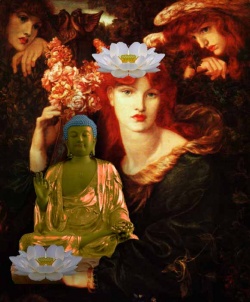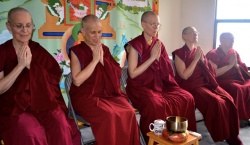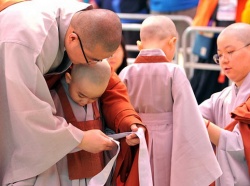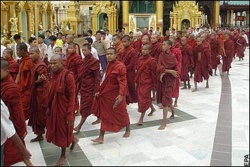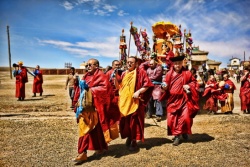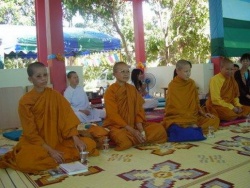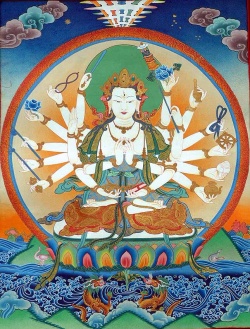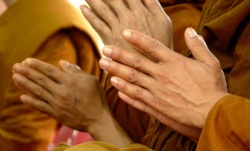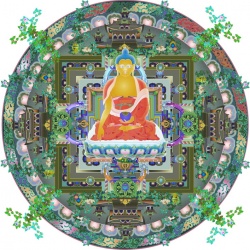Difference between revisions of "Maha Ati: Natural Liberation Through Primordial Awareness"
m (Text replacement - "]]]" to "]])") |
|||
| Line 218: | Line 218: | ||
Treading a [[path]] to reach what cannot be reached by treading [[causes]] deviation; | Treading a [[path]] to reach what cannot be reached by treading [[causes]] deviation; | ||
| − | seeking to understand conceptually that which cannot become an [[object]] [of [[thought]] | + | seeking to understand conceptually that which cannot become an [[object]] [of [[thought]]) [[causes]] the [[hindrances]] that obstruct understanding…seeking something and striving to obtain it constitute deviation. (18) |
Latest revision as of 19:55, 4 April 2016
INTRODUCTION
Maha Ati: Natural Liberation Through Primordial Awareness
(1) is a general introductory overview of the path popularly known as Tibetan Buddhist Dzogchen.
It is based in the Longchen Nyingthik tradition, Rigdzin Jigme Lingpa’s (1730-1798) revision of Kunkhyen Longchen Rabjam’s (1308-1363) original transmission of Maha Ati.
Longchen Nyingthik is rooted in the Nyingmapa or “Ancient School” synonymous with the “Early Dissemination of the Buddhist Doctrine” as it found its way to Tibet from India prior to the end of the tenth century CE.
The essay also attempts, by way of comparison, to place this tradition side by side with indigenous Bonpo (See Footnotes, section #7.)
Dzogchen, the doctrines of the Kagyupa, and the “New Translation” schools of Tibetan Buddhism.
In these practices the ground from which imagination resolves itself in apparent phenomena is revealed.
Though it ceaselessly arises everywhere, it is not recognized.
-Padmasambhava
Somewhere in the absolute, unfathomable, timeless, un-originated quintessence of eternally divine consciousness, is Samantabhadra, the primordial empty form of Buddha.
Blue-black as the night sky, Samantrabhadra and his pure white Wisdom consort Samantrabhadri effortlessly project the Dharmakaya, the truth body, of all the Buddhas. (2)
The Ati-Buddha Samantabhadra is in reality a metaphor for our own original pure state that always has been and always will remain pure, with diamond-like indestructibility never conditioned by dualism.
It has been said of this so-called Great Perfection, that even if all the Victorious Ones (i.e., Buddhas) of all the three times (past, present, future) were to deliberate together, they would find nothing beyond this Primordial State.
It is the end of all paths to enlightenment, the Essence of Mind, and the quintessence of the Fruit: there is no higher realization.
Regaining this original ground of being is complicated by Samsara, the illusion that the apparent world of forms is other than oneself, and Nirvana, the concept that to transcend illusion is something to be desired.
It is said in the Great Perfection teachings that one cannot become enlightened through a contrived mind; rather, the basic mind is to be identified, in relation to which all phenomena are to be understood as the sport of the mind.
-The Dalai Lama (3)
Maha Ati, the primary teaching of this celestial Ati-Buddha at the pinnacle of the most profound ultimate reality, is bestowed first upon heavenly beings and by progressive transmissions (gyalwa gong-gyu, “thought,” or “mind lineage”) into the human realm.
This is accomplished through adhishthana, “energy” or “grace,” continually regenerating itself through the flow of the transmitting act.
The first Nirmanakaya—incarnate master—of Maha Ati was Vajrayana guru Garab Dorje (dGa’rab rDo rje), whose name means “Vajra of Supreme happiness” and of whom it was said, “At the very instant of having mind nature pointed out, [he] became a fully enlightened Buddha without having undergone any training whatsoever.”
(4)
Garab Dorje transmitted Maha Ati to various Indian masters including Manjusrimitra, who obtained instant realization simply by observing a gesture of “direct introduction” from his master. Garab Dorje wrote the following teaching:
Mind’s nature is Buddha from the beginning.
It has neither birth nor cessation, like space.
When you realize the real meaning of the equal nature of all things,
To remain in that state without searching is meditation.
Manjusrimitra then expressed his understanding of this instruction:
I Am Manjushrimitra
I have attained the accomplishment of Yamantaka.
I have realized the great equality of samsara and nirvana;
Omniscient primal wisdom has arisen. (5)
Manjusrimitra passed the Maha Ati teaching “beyond the karmic law of cause and effect” to Shri Singha, who transmitted it to Padmasambhava, Vimalamitra, Vairochana the translator, and Jnanasutra.
Three “classes” or divisions of Maha Ati Yoga are attributed to three of these masters, the first two:
sem-dhe, the Mind class, and
long-dhe, the Space class, were introduced by Vairochana,
while man-ngag-dhe, the Instruction, or “Secret Instruction” class, was transmitted by Vimalamitra and Padmasambhava.
Two important practices complete the “Secret Instruction” class phase of Maha Ati, beyond the quality of “clarity” found in the initial Mind Class, and the “empty” quality of the secondary Space Class.
These practices are known as trekcho, “cutting through” to primal purity, akin to the solve phase of the famous alchemical dictum solve et coagula (dissolve and coagulate -and you will achieve mastery), and thogal, “direct leap” into spontaneous presence.
The Indian Tantric adept, “Lotus born” Padmasambhava brought the dharma to Tibet in the eighth century in order to revivify Buddhism.
The legend of this “Second Buddha’s” arrival in Tibet includes the description of his spontaneous appearance on a lotus blossom in the middle of Dhanakosha Lake.
(6)
Padmasambhava came to Tibet at the request of King Trisong Detsun—himself an incarnation of the Bodhisattva Manjushri—from a country called Oddiyana, a quasi-mythical kingdom that is said to have been located in the area of the Swat valley in what is now modern-day Pakistan.
Padmasambhava’s mission to Tibet involved dispelling—in his “wrathful” form as Dorje Trolo—the indigenous protective deities that were not at all sympathetic to a new wave of Tantric Buddhism infiltrating the country’s borders.
Padmasambhava used the opportunity to not only tame these “demons” but also to assimilate and syncretize certain aspects of Tibetan Bon tradition.
One of these features he recognized as Maha Ati, known in Bon as rdzogs chen, “Dzogchen.” (7)
Padmasambhava also transmitted Anu-yoga, in the same class known as the Inner or Internal Tantras.
Anu-yoga emphasizes meditation on emptiness and the physical body, its essences, subtle channels, and energies.
According to the Nyingmapa school, the various systems of teachings are subdivided into the following nine paths or “vehicles” culminating in purified Maha Ati awareness.
The first three generally teach the way of renunciation (spong lam), the second three teach purification (sbyong lam), and the last three the way of transformation (sgyur lam):
1. The worldly vehicle of divinities and men (‘jig rten Iha mi’I theg pa), including all non-Buddhist religions.
2. The vehicle of the shravakas (listeners) and of the pratyekabuddhas –those who seek enlightenment solely for their own sake, i.e.; Hinayana Buddhism.
3. The vehicle of the bodhisattvas, consisting of the teachings of Mahayana Buddhism.
Next appear the three vehicles known as the External Tantras.
These teachings and practices are concerned with purification and preparation to receive the wisdom teachings of realized beings that follow.
These vehicles are known as:
4. Kriya Tantra;
5. Ubhava Tantra; and
6. Yoga Tantra.
Concerning the next three vehicles, strictly speaking only 7.
Maha-yoga, and,
8. Anu-yoga,
are known as Internal Tantras.
Classed as tantras, they are teachings and practices involved primarily with the transformation of the individual into the pure dimension of realization.
9. Ati-yoga, the self-liberated state, is based on the direct experiential knowledge of the primordial state, the joining (or realization of the inseparability) of what is known as the Path (or: Child) and Mother Luminosity.
The other three primary Tibetan Buddhist religious schools,
the Kagyudpa (bKa’ rgyud pa),
the Sakyapa (Sa skya pa) and
the Gelugpa (dGe lugs pa) list the following as higher tantras, or Anuttara Tantras:
1. Pitri-yoga:
Father Tantras.
2. Matri-yoga: Mother Tantras.
3. Advitya-yoga: Non-Dual Tantras.
(8)
Although scholars clinging to this school of thought or that disagree on this point, Advitya-yoga is essentially indistinguishable from Advaita Vedanta’s ultimate non-dual realization. (9)
In Ramana Maharshi’s contemporary elucidation of ancient Vedic non-dualism through self-enquiry, sadhanas can support ultimate realization.
They are “pointing to” instructions and practices that literally ground the resulting experiences and prepare one for the relinquishment of conceptualization. (10)
In one of the oral meditation instructions attributed to Manjusrimitra we find:
“Here a spontaneous, unpremeditated way of acting, in which one does not have to avoid any situation as negative, for example, is only possible having had some experience of ‘non-doing’ in meditation.”
And earlier: “Non-action is basically the discovery of freedom as something inseparable from our being; it cannot be created.” (11)
This realization requires nothing more than apprehending mundane reality as Maha Ati awareness already complete and perfect, independent of any transformation or renunciation on the part of a practitioner.
Whereas achieving Buddha nature through more conventional means might be seen as a development, or series of developments over time, known as the “gradual path,” awareness of Maha Ati is very direct and happens all at once.
One only has to recognize experience naturally arising just as it is, without attachment or rejection (judgment) encompassing the overlay of arbitrary meaning assumed by the dualistic conceptual mind.
Phenomena arising as thought or image are spontaneously considered as the mind’s nature and inexhaustible energy, already perfected.
…the nature of the mind is likened to a mirror, and phenomena are like the reflections seen in that mirror.
Whether these reflections are good or bad, beautiful or ugly, pure or impure, they in no way modify or limit the nature of the mirror.
It is the same with one’s own nature of mind.
–John Myrdhin Reynolds (12)
Maha Ati teachings require a leap beyond “ordinary mind” and in the Tibetan schools is generally reserved for practitioners who have extensive experience in meditation, those who have traversed the paths of the renunciation, purification, and transformation vehicles.
All agree that it requires transmission and guidance from a Master.
According to scholar Robert Thurman,
It teaches the most advanced, radical vision of non-duality, the Buddha-vision accessible to the psychonaut once he or she has been able consciously to traverse the death experience and can remember the clear-light translucency of ultimate mind. (13)
A text attributed to Padmasambhava through Yeshe Tsogyal, his Tantric disciple, wife-consort, and scribe, known as Self-Liberation By Meditation Upon the Peaceful and Wrathful Deities (subtitled):
“The Yoga of Knowing the Mind, the Seeing of Reality, Called Self-Liberation,” (14) uncompromisingly emphasizes this view,
“There being really no duality, pluralism is untrue. Until duality is transcended and at-one-ment realized, Enlightenment cannot be attained.
The whole Sangsara and Nirvana, as an inseparable unity, are one’s mind.” (15)
The Subtlety of True Mind transcends the law of cause and effect, time, space, and the ordinary and the saintly. There is no particular in it.
Just like empty space, it pervades the universe.
The Subtlety of the True Mind can never be expressed in words nor exist nor non-exist in time.
It is neither in motion nor in fixation. However, the Subtlety of the True Mind is clearly there.
It is called “The Previous Master of the House” or the “Master who has lived for many kalpas (Bhisma-garjita-ghosa-svara-raja)” or, “One’s own Self lived for long kalpas.”
-Dr. Kyung Bo-Seo (16)
Maha Ati in its purest sense is not dogmatic or a part of a separate system, although it has been assimilated into the different branches of Tibetan religion.
As javanmardi for example, is regarded in relationship to Chivalry, Sufism, and Islam, Maha Ati’s origins, names, and “affiliations” are irrelevant, as the potential for realizing this awareness is always present and available, independent of a particular religious vehicle. (17)
Just this nature of pure and total consciousness is the ultimate essence of all that exists…
Treading a path to reach what cannot be reached by treading causes deviation;
seeking to understand conceptually that which cannot become an object [of thought) causes the hindrances that obstruct understanding…seeking something and striving to obtain it constitute deviation. (18)
For something so basic and essentially beyond description, Maha Ati has been subject to innumerable interpretations that inevitably share the same basic characteristics.
Certain Masters over time have found it necessary to clarify their copious instruction, breaking the teachings down to basics.
This expansion and contraction was most eloquently apparent when Garab Dorje imparted three verses to his disciple Manjusrimitra summing up his initial revelation consisting of some 6,400,000 verses!
The three verses follow “The Three Words That Strike To The Heart:”
View. The view is to recognize one’s own nature.
Practice. The practice is to decide on one point, namely that nature.
Result. The result is to gain confidence in liberation.
Many instructional texts, especially in Mahayana Buddhism (19), refer to the three dimensions, or three kayas or “bodies” that
a Buddha possesses: Dharmakaya, Samboghkaya, and Nirmanakaya in the same way, as,
Base
Path
Fruit
Dharmakaya is the basis for everything and is not disconnected from anything.
It is the common absolute empty nature of all Buddhas identical with all that exists.
Here, Samantabhadra abides beyond dualism: vast, limitless sparkling empty space full of infinite potential.
This is the essential nature, a luminosity expressed in the clarity of manifestation that is Sambhogakaya.
The expressive ever-present energy within the luminosity is Nirmanakaya.
The sparkling clear light of luminous unlimited energy that pervades all three kayas is known as Rigpa.
Rigpa is also indistinguishable from the Base, the ground of being, known in Bon as kunzhi, the unity of clarity and emptiness found in the constant natural indeterminate open unfolding of appearance and awareness.
The three kayas introduced as View, Practice, and Result, or Base, Path, and Fruit, are not progressive steps but are rather simultaneously present and interdependent.
They are always apparent, and are in fact, all that there is contained and uncontained within and without “reality,” noumenon and phenomenon, inside conceptualizations as well as outside of them.
All “happen” at once, and are present at the same “time” beyond time and space.
Whether or not we consider them as “together” or “separate” depends on our understanding or ignorance of the ever-present basis for what is—or isn’t—“happening.”
The ordinary mind of dualistic perception is the great demon of conditioned existence that causes one to wander in the three realms of Samsara.
-Dudjom Lingpa, in a vision of Manjusrimitra (20)
Rigpa, which transcends the ordinary mind,
Is the special feature of the natural Dzogapachenpo.
-Jikme Lingpa (21)
Words may “point to” but ultimately fail to make the case, for what we attempt to illustrate by description, no matter how precise or poetic, is in the end neither “existent” nor “non-existent.”
One cannot use concepts to describe non-conceptualization other than by pointing out that this in itself remains “dualistic.”
Enlightenment is merely a name indicating what is called the ‘natural condition’, one’s own mind: just this very mind, unaltered, is Dharmakaya.
What has never been altered is also what has never been born, and the true ‘unborn’ cannot be sought or realized through effort. (22)
Then even this non-existence, which is dependant upon existence, is non-existent. Also, the non-existence of this non-existence does not exist. (23)
(1)Various transliterations of names and terms found in this essay adhere to the versions encountered in the research. Sanskrit and Tibetan are used interchangeably.
For example, “Maha Ati” is also known as “Dzogchen,” but the former is preferred here because when first encountered by the author this is the way it was translated in a teaching by Dilgo Khyentse Rinpoche.(1)
(2)Samantabhadra (Kuntuzangpo in Tibetan) is the name used in the Nyingmapa “Ancient School” tradition of Tibetan Buddhism.
This primal Buddha is also known as, or is supplanted by, Vajradhara in the “New Translation” schools.(2)
(3)Foreword to The Words of My Perfect Teacher p xxv.(3)
(4)Tulku Urgen Rinpoche, Rainbow Painting, p 121. Of course, in Buddhism, the historical Buddha: Gautama Siddhartha, was the first Nirmanakaya manifestation and blueprint for enlightenment.
In Bon tradition, Samantabhadra (Kuntuzangpo) first transmitted Maha Ati (technically, the Dzogchen teachings of the Oral Transmission of Shang Shung) to Sangwa Dupa, and then through a succession of masters to Tapihritsa, one of two principal masters in the Zhang Zhung Nyan Gyud Dzogchen lineage.
See Namkhai Norbu, 1995, Drung, Deu and Bon. Library of Tibetan Works and Archives, New Delhi.
It should be noted here that both the Bon, and Nyingmapa Buddhist traditions “claim” the origination and subsequent lineage of Dzogchen (Maha Ati) awareness in Tibet.(4)
(5)The Words of My Perfect Teacher, p 340. Yamantaka is the wrathful form of Manjusri, namesake of this sage and Bodhisattva embodiment of wisdom that cuts through ignorance with diamond sharp clarity.(5)
(6)See: The Tibetan Book of the Great Liberation, pp 101-192, “An Epitome of the Life and Teachings of Tibet’s Great Guru Padma-sambhava” a summary taken from the “Unabridged Biography of the Urgyan Guru Padma-Sambhava: The Golden Rosary of Teachings Illuminating the Path of Liberation” by Yeshe Tsogyal.(6)
(7)According to Tibetan Bon tradition, Shenrab Miwoche (gShen rab mi bo che) founded Bon over seventeen thousand years ago.
Shenla Odker is his Sambogakaya form, representing the union of all Bon Dzogchen masters.
Similar but at odds fundamentally, claiming different historical Nirmanakaya “Buddhas” as founders for example, the indigenous Tibetan tradition of Bon and the four schools of Tibetan Buddhism have recently been reconciled by His Holiness the Dalai Lama, who has recognized Bon as the “fifth religious school” and has given Bon practitioners representation on the Council of Religious Affairs at Dharmasala(7)
(8)This list is based on the one found in Dzogchen – The Self Perfected State, pp 15, 16.(8)
(9)…And realized mystics disagree as well, see Trungpa Rinpoche’s lively essay “Maha Ati” in The Essential Chogyam Trungpa, 1999, Shambala, Boston, first paragraph, p 197.(9)
(10)There is an interesting connection between Ramana’s “Who am I?” and Dzogchen master Namkhai Norbu’s frontispiece to his book The Supreme Source:
“This ‘I’ is your true state: the primordial Buddha, the supreme source of manifestation.”
Otherwise, the criticism that Maha Ati is simply a wolf in Samkhya clothing is simply a misunderstanding first of terms (i.e., a “true” meaning of “Self”), and then of discernment (viveka).
Samkhya literally means “number” and involves the divisive understanding of things (such as tattwas) that are categorized accordingly. (10)
(11)Primordial Experience, p 32.(11)
(12)The Golden Letters, p 34.(12)
(13)Essential Tibetan Buddhism, p 315.(13)
(14)See: The Tibetan Book of the Great Liberation, Book II, pp 194-240.(14)
(15)ibid, p 207.(15)
(16)“Master BoJo’s Zen Teachings” Maitreya, p 12.(16)
(17)On javanmardi also known as futuwwah, see Ibn al-Husayn al-Sulami, 1991. The Way of Sufi Chivalry, Inner Traditions, Rochester. This illustration was not chosen at random:
John Myrdhin Reynolds (Vajranatha) has pointed out in his book on Dzogchen The Golden Letters, via the Foreword (p 15) by Namkhai Norbu Rinpoche, and also through oral communication from Bon Master Lopon Tenzin Namdak, that many old Bon texts, including the Bonpo Mother Tantra, were originally translated from the ancient Persian dialect Pahlavi, (now known as Farsi), and that Tonpa Shenrab Miwoche, traditionally cited as the founder of Bon, is said to have come from Tazig, a Pahlavi-speaking area of Central Asia.(17)
(18)The Supreme Source, pp 144-147.(18)
(19)Recapping the three traditional Buddhist yanas:
Hinayana, in which the individual perfects himself for his own liberation’s sake;
Mahayana, where individual liberation is expanded to include within it the liberation of all sentient beings, this shift being marked by the Bodhisattva vow;
and Vajrayana, which cuts through to the heart of liberation beyond limitation. All three yanas may ultimately culminate in Maha Ati awareness.(19)
